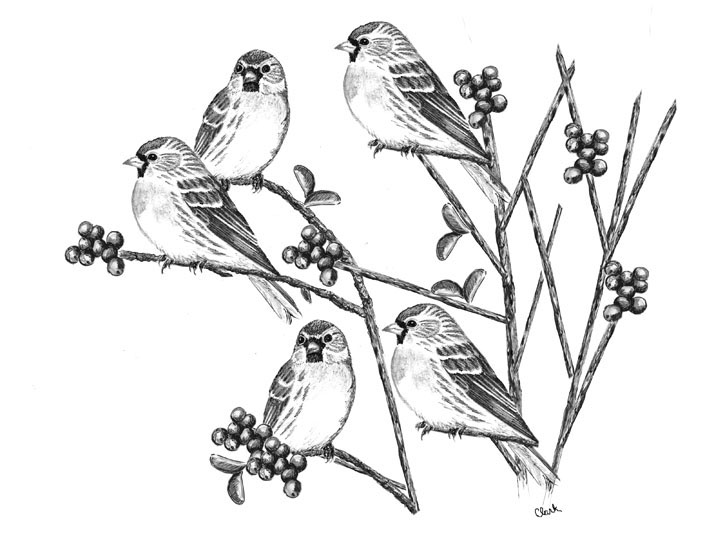
Dear Bird Folks,
I’ve been reading about the influx of birds from Canada this winter. Have you heard any reports about redpolls arriving, and also, do they ever visit bird feeders?
– Tim, Harwich, MA
Yes, Tim,
I have indeed heard reports of redpolls being in our area this winter. None (that I know of) have been seen on bird feeders, but it’s still a possibility. I had redpolls on my feeder years ago, or at least I think I did; the details are kind of foggy. Another possibility is that I only dreamed I had them. While most people dream about becoming rock stars or sports heroes, I dream about birds on my feeder. What can I say?
For those folks who aren’t familiar with redpolls, or who also have foggy memories, here’s what you need to know. A redpoll is a small finch that somewhat resembles our resident House Finch. It has a stubby yellow beak, brown streaky body, a patch of red on its forehead and a bit of black on its face. Some people describe the redpoll as the finch with a red beret and black goatee…like a beat poet from the ‘50s.
They are small birds, weighing less than half an ounce, and appear to be somewhat fragile, but such is not the case. Redpolls reside in some of the most isolated and coldest areas in the world…and they actually like it that way. Numbering in the millions and found throughout Alaska, Canada, Greenland, Scandinavia and Siberia, Common Redpolls clearly know how to deal with really cold weather. How cold is “really cold”? These little birds can survive temps as low as -50°F, and even -60°F (but that’s in Siberia, so vodka is likely involved).
One of the ways redpolls deal with the extremely low temperatures is to dress warmer. Humans add more layers when it gets cold and so do Redpolls, by increasing their feather density by over thirty percent each winter. In addition, redpolls often use snow as insulation. Snow? On really cold nights the birds will actually burrow into the snow to keep warm. It seems a bit counterproductive, but when the air temperature is -60°, a snow cave is actually a better option. The birds are also relentless foragers, often feeding well after sunset, using the last bit of daylight to find food. When they’ve eaten their fill, they will continue gathering more food, storing extra seeds in special throat pouches. The birds use these additional seeds for a midnight snack, consuming heat-producing food while roosting. In other words, in order to survive frigid nights, redpolls simply eat in bed. (The birds are lucky; my wife won’t let me eat in bed anymore. A tasty bowl of soup at 3:00AM sure seemed harmless at the time.)
Redpolls may be great at finding and storing food, but that only works when food is available. As is the case with many northern birds this year, they’ve headed our way because the usual northern bounty hasn’t been very bountiful. After receiving your note, I scanned the Cape’s recent bird reports for any redpoll sightings and noticed that a small flock was seen a few days before Christmas near Truro’s Corn Hill Beach. Unfortunately, between the rotten weather and family holiday Zoom obligations, I wasn’t able to do any birding for a few days. I finally made it to Corn Hill yesterday and wow, it was cold. It wasn’t -60°, but with the wind blasting off Cape Cod Bay, it seemed colder. At first I walked the neighborhood off Corn Hill Road (mostly to get out of the wind). Birds like this area, mostly because the residents (except for one bonehead) have left their yards natural, thoughtfully omitting evil lawns and imported plants. I saw lots of charming Yellow-rumped Warblers, but not a single redpoll. Sigh! I don’t know what is going on lately, but I’ve had better luck playing the lottery than finding birds. I walked back to my car to warm up.
Just south of the beach parking lot is the old Cape Cod Railroad bed, which is now just a skinny strip of land that cuts through the salt marsh, eventually leading to Pamet Harbor. I had never walked this trail before, so today seemed like a good day to check it out. Five minutes down the trail a flock of small birds flew from a pitch pine out over the marsh. They went so fast and so far I couldn’t tell what they were. Redpolls are notorious for being extremely tame, but whatever these birds were, they wanted nothing to do with me. So much for being tame. Thirty seconds later I had to eat those words as the entire flock returned and landed on a bush ten inches in front of me. There they were, direct from somewhere near the Arctic Circle, twenty-five redpolls, all super tame and all wondering why I thought it was cold outside. It was a balmy day by their standards. When the birds finally got tired of looking at me, they hopped onto the ground and began eating the seeds of beach plants (sea lavender?). It was so cool. I took a few photos (more like a hundred) and eventually left the birds to eat in peace. My birding luck had changed.
So far, Tim, redpoll reports have been limited, with no news of them eating from feeders, but it’s still a possibility. The best you can do to attract them is put out their favorite foods. Just remember, they’ll eat some seeds right away and then save a bit more for later at night. You should put out thistle or hulled sunflower, which is their favorite. But I wouldn’t offer them any soup. That won’t end well. Believe me.